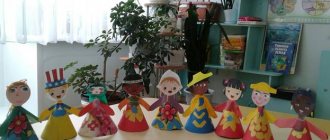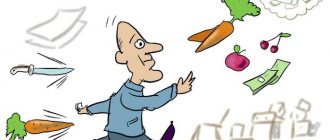Long-term planning for October. Preparatory group
October 1.Week. Life of peasants in autumn. Vegetables Monday 1 . Adult labor “Man has always worked” O.F. Gorbatenko (5, p. 109) C. to form children’s ideas that labor has always existed, but its means and forms have changed in connection with technical progress; maintain children's interest in different professions, from the relationship; develop the ability to make inferences and judgments 2. Physical development Tuesday 1. Speech development 5 Collective storytelling O.S. Ushakova (4, p. 303) C. train children in the use of complex sentences, in coordinating adjectives with nouns in gender and number; learn to select words of the same root 2. World of Music 3. Modeling “Vegetables” Ts. learn to sculpt in different ways Wednesday 1. Mathematical development 5 “Polygon” (6, p. 16) V.P. Novikova Ts. introduce children to the polygon and its features : sides, angles, vertices, their one-to-one correspondence; practice counting within 10 2. Physical development 3. Circle “Golden Gramophone” Thursday 1. Teaching literacy 5 “The letter and sound O” (Astafieva E.O.5, p. 22) C. consolidate knowledge of the signs of autumn, teach to see them in a black and white picture, highlighting the sound O and determining its place in the word; learn to select words to a given sound pattern. 2. World of Music 3. Club “Young Ecologist” Friday 1. Application “Gifts of Autumn” (10, p. 150) Teach on your own, cut out various leaf shapes from a sheet of paper folded in half several times 2. Fiction 3 Memorization poem by A.S. Pushkin “The sky was already breathing in autumn” by O.S. Ushakov (8, p. 168) Ts. teach children to expressively read a poem by heart, conveying the sadness of autumn nature with intonation, to feel, understand and reproduce the imagery of the language of the poem; expand ideas about the landscape lyrics of A.S. Pushkin 2. Week. Orchard Monday 1. Local history “How Russia came into being. The symbols of the country are the coat of arms, flag, anthem” (4, p. 76) C. consolidate knowledge about the nature of Russia; introduce the history of the country, its symbols; cultivate interest in the history of your country, a sense of love and pride 2. Physical development Tuesday 1. Speech development 6 Inventing a fairy tale on the theme “The Hare’s Birthday” O.S. Ushakova (10, p. 313) C. teach children to independently invent a fairy tale on a given topic according to plan; using descriptions, dialogue, when evaluating fairy tales, note the entertaining nature of the plot, means of expression; practice forming the accusative plural form of nouns; practice in clearly pronouncing nursery rhymes, in the differences in rhythm, tempo of speech and voice strength 2. The world of music 3. Drawing
“Autumn still life” (11, p. 117) C. exercise in combining various drawing techniques Wednesday 1. Mathematical development 6 “Geometric figures” by V.P. Novikov (7, p. 18) C. introduce children to ways of drawing a polygon in notebooks; continue to teach understanding quantitative relationships between numbers within 10; learn to write using the signs “>”, “<”,=,=; read the entry; learn to increase and decrease a number by one; practice counting by touch 2. Physical development 3. Circle “Golden Gramophone” Thursday 1. Teaching literacy 6 “Sound and letter I” (Astafieva E.O. 5, p. 23) C. consolidate the general concepts of vegetables and fruits. Teaches to recognize familiar objects depicted in outline; consolidate knowledge and coloring of vegetables and fruits, highlighting the sound I and determine its place in the word. Guess the intended word by its first and last letter 2. World of Music 3. Club “Young Ecologist” Friday 1. Construction “Bridges” (6, p. 32) L.V. Kutsakova Ts. improve children’s ability to design bridges for various purposes; practice building diagrams and drawings of bridges; improve the ability to design moving mechanisms from a construction set, build a simple mechanism - a lever, which allows you to set in motion individual structural elements 2. Natural world 3 Visit to the cafe “Gifts of Autumn”. O.A. Voronkevich (2, p. 321) C. systematize children’s ideas about fruits and vegetables; practice writing a story about vegetables and fruits; introduce the technology of preparing dishes from them. Physical development (on a walk) 3. Week. Insects Monday 1. Etiquette “Country of Politeness” by L.L. Mosaleva (p. 56) It is appropriate to teach C., depending on the situation and the addressee, to use polite words of greeting; teach a general culture of behavior, kind, respectful attitude towards each other 2. Physical development Tuesday 1. Speech development 7 Retelling of V. Bianki’s story “Bathing Bear Cubs” by O. S. Ushakova (5, p. 305) C. develop in children the ability to connect in a single whole of individual parts of the story, conveying the text accurately, consistently, expressively; practice selecting synonyms and antonyms for adjectives and verbs; clarify and consolidate the correct pronunciation of the sounds Z and Z 2. The world of music 3. Modeling “Insects” C. learn to sculpt insects Wednesday 1. Mathematical development 7 “Fast, slow” by V.P. Novikova (8, p. 21) C. teach form a figure of eight triangles; fix the names of geometric shapes (triangle, polygon); practice counting within 10; consolidate the concepts: “faster”, “slower”; consolidate the names of the seasons and months 2. Physical development. 3. Circle “Golden Gramophone” Thursday 1 Literacy training 7 “Dog and Cow” (Astafieva E.O. 7, p. 24) Ts. continue to teach children to select words with a given sound, determining the place of the sound in the word, the hardness and softness of the consonant ; consolidate the ability to come up with words for a given syllable (MU-flour, MA-machine), consolidate the correct spelling of the letter M; learn to analyze the image of a familiar object, made up of geometric shapes and letters 2. World of Music 3. Club “Young Ecologist” Friday 1. Application “Butterfly” C. consolidate the ability from paper folded in half, cut out symmetrical shapes, arrange them beautifully 2. Artistic literature 4 Introduction to a new genre - fable. Reading the fable by I.A. Krylov “The Dragonfly and the Ant” by O.S. Ushakov (10, p. 170) Ts. to acquaint children with the fable, with its genre features; help understand the allegory of the fable, ideas, meaning of proverbs about work; to cultivate sensitivity to the figurative structure of the fable, to teach how to connect the meaning of a proverb with a specific situation 4. Week. Migratory birds Monday 1. Safety “When danger threatens you” O.F. Gorbatenko (28, p. 148) C. expand ideas about the danger that can arise at home, on the street, in transport, etc.; develop skills in proper handling of electrical appliances and other objects, rules of behavior when communicating with strangers 2. Physical development Tuesday 1. Speech development 8 Storytelling based on the painting “Fox with Cubs” by O.S. Ushakova (12, p. 317) Ts. teach children to compose a plot story based on the picture, observing consistency, accuracy and expressiveness; learn to select definitions, make phrases with given words; practice word formation Wednesday 1. Mathematical development 8 “Money” by V.P. Novikov (11, p. 29) C. introduce children to money and its purpose; practice orientation on a sheet of paper: learn to put dots at the intersection of lines (connect dots along drawn lines); exercise orientation in space 2. Physical development 3. Circle “Golden Gramophone” Thursday 1. Teaching literacy 8 “Leaf fall” (Astafieva E.O. 5, p. 26) C. learn to form adjectives from nouns (oak - oak, willow - willow), continue to find objects in the picture whose names contain the given sound P, determining its place in the sound; consolidate the ability to identify familiar vowels in these words and determine their place in the word. 2. World of Music 3. Club “Young Ecologist” Friday 1. Design “Bird” by L.V. Kutsakova (3, p. 19) Ts. generalize, systematize, clarify children’s ideas about migratory birds, teach how to make figures from paper 2. Natural world 4 “How our feathered friends live in winter” O.A. Voronkovich (1, p. 354) C. summarize children’s knowledge gained from bird observations; establish a connection between the shape of the beak and the nutrition of birds; note the relationships between birds during wintering. Create a desire to help our winged friends during the winter lack of food 3. Physical development (on a walk)
We recommend watching:
Long-term planning for February. Preparatory group Long-term planning for January. Preparatory group Long-term planning for December. Preparatory group Long-term planning for November. Preparatory group
Similar articles:
Long-term work plan for visual activities and the development of creative abilities in the middle group
Long-term plan for oral folk art in the senior, preparatory group
Plan of interaction with families of children of the middle group of general developmental orientation
Methodological recommendations for drawing up an individual development program


